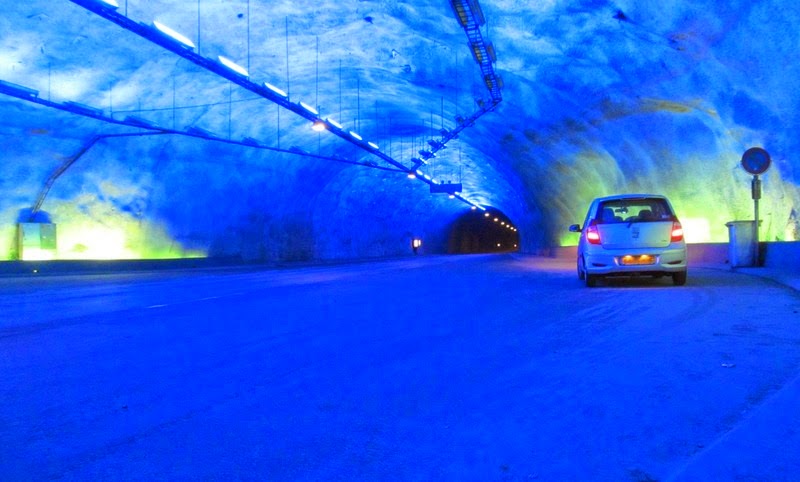Tunnels of the world
Contents |
[edit] Channel Tunnel (UK and France)
The Channel Tunnel carries high-speed Eurostar trains beneath the English Channel to and from Folkestone in Kent, UK and Pas-de-Calais in France. The tunnel’s total length is 31.4 miles (50.5 km), with 23.5 miles (37.9 km) undersea, making it the longest undersea tunnel in the world.
Whilst the original idea was proposed as far back as 1802, it was only in June 1988 that the first tunnelling work began, and it was formally opened in May 1994.
At its lowest point the tunnel is 75 m (250 ft) deep, and trains are capable of travelling at 160 km/hr (99 mph).
[edit] Laerdal Tunnel (Aurland, Norway)
The Laerdal Tunnel (see top image) is a road tunnel connecting Laerdal and Aurland in West Norway. At 15.23 miles (24.51 km), it is the longest road tunnel in the world. Work began in 1995, and involved tunnelling through a mountain range. It was completed in 2000.
The project was innovative in the way that engineers sought to alleviate the psychological strain of driving for 20 minutes through a tunnel. It is lit with white and yellow lights to give the impression of sunrise, together with three large cave sections that allow for rest breaks and to give the illusion that drivers are travelling through a number of smaller tunnels.
[edit] Tokyo Bay Aqua-Line (Tokyo, Japan)
The Aqua Line crosses Tokyo Bay connecting the cities of Kawasaki and Kisarazu. With an overall length of 14 km (8.7 miles) it incorporates a 4.4 km section of steel box girder bridge with orthotropic deck and a 9.6 km section of underwater bored shield tunnel. Where the bridge and tunnel intersect there is an artificial island that serves as a rest area for drivers.
After 23 years of planning, the Aqua Line opened in December 1997, setting a precedent for constructing two-lane road tunnels. It was designed with earthquake resilience in mind, as was demonstrated in a 2011 earthquake that caused severe damage to Tokyo Bay.
[edit] Eisenhower Tunnel (Colorado, USA)
The Eisenhower Tunnel is a twin-bore tunnel under the Continental Divide in the Rocky Mountains. Though the project was only supposed to take 3 years to complete, complications arose when the boring machines could not work to their usual productivity level at such high elevations. When completed in 1979 it became the highest road tunnel in the world, at 3,401 m (11,158 ft) above sea level. The length of the tunnel is 1.7 miles (2.72 km).
[edit] SMART (Kuala Lumpur, Malaysia)
The ‘Stormwater Management and Road Tunnel’ is the second longest stormwater tunnel in Asia, at 6 miles (9.7 km). The main purpose of the tunnel is to alleviate the problem of Kuala Lumpur’s flash flooding, by allowing storm water to flood the tunnel, as well as serving as a road to reduce rush hour traffic congestion. The rainwater is diverted into a lower channel, whilst road traffic travels along the upper level. Automated water-tight gates are opened and closed to allow the flood waters to pass through.
[edit] Seikan Tunnel (Japan)
At 14.2 miles (23 km) long and 140 m (460 ft), the Seikan is the longest and deepest rail tunnel in the world. It spans the Tsugaru Strait that connects the islands of Honshu and Hokkaido, a risky journey by water due to the unpredictable weather such that an underground tunnel had long been an aspiration. The double track rail tunnel allows an operating speed of 140 km/h (85 mph).
The rock and soil under the strait made it impossible to use a tunnel boring machine, so dynamite and drills had to be used to blast out more than 30 miles of the tunnel, a considerable engineering feat especially since it was achieved through a known earthquake zone.
[edit] Related articles on Designing Buildings Wiki
- 7 Engineering Wonders of the World.
- 9 of the world’s most impressive structures.
- Bridge construction.
- Bridges of the world.
- Building of the week series.
- Channel.
- Chesapeake Bay Bridge-Tunnel.
- Civil engineering dream projects.
- East West Metro Tunnel, Calcutta.
- Follo Line, Norway.
- Global undergrounds - exploring cities within.
- River engineering.
- Stad Ship Tunnel.
- Tunnelling.
- Tunnel Engineering Exhibition 2017.
[edit] External references
- CNN - Great tunnels
Featured articles and news
Infrastructure that connect the physical and digital domains.
Harnessing robotics and AI in challenging environments
The key to nuclear decommissioning and fusion engineering.
BSRIA announces Lisa Ashworth as new CEO
Tasked with furthering BSRIA’s impressive growth ambitions.
Public buildings get half a million energy efficiency boost
£557 million to switch to cleaner heating and save on energy.
CIOB launches pre-election manifesto
Outlining potential future policies for the next government.
Grenfell Tower Inquiry announcement
Phase 2 hearings come to a close and the final report due in September.
Progress from Parts L, F and O: A whitepaper, one year on.
A replicated study to understand the opinion of practitioners.
ECA announces new president 2024
Electrical engineer and business leader Stuart Smith.
A distinct type of countryside that should be celebrated.
Should Part O be extended to existing buildings?
EAC brands heatwave adaptation a missed opportunity.
Definition of Statutory in workplace and facilities management
Established by IWFM, BESA, CIBSE and BSRIA.
Tackling the transition from traditional heating systems
59% lack the necessary information and confidence to switch.
The general election and the construction industry
As PM, Rishi Sunak announces July 4 date for an election.
Eco apprenticeships continue help grow green workforce
A year after being recognised at the King's coronation.
Permitted development rights for agricultural buildings
The changes coming into effect as of May 21, 2024.























Comments
The excavation method of TBM + Conveyor is the most efficient way for long and wide tunnels.
A vertical conveyor for deep shaft to lift mucks to ground is safer and quicker.